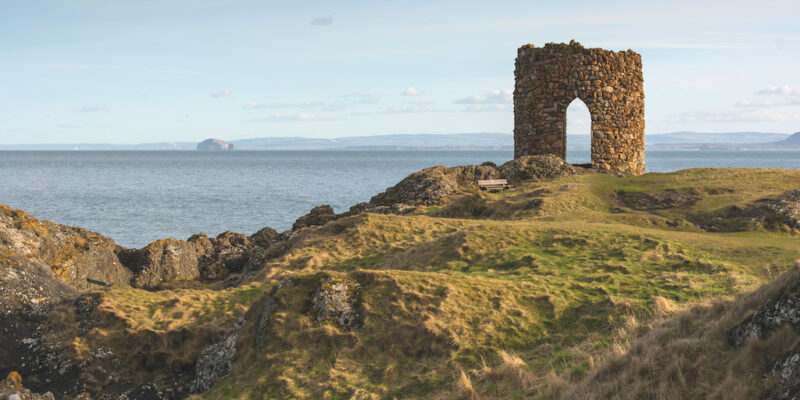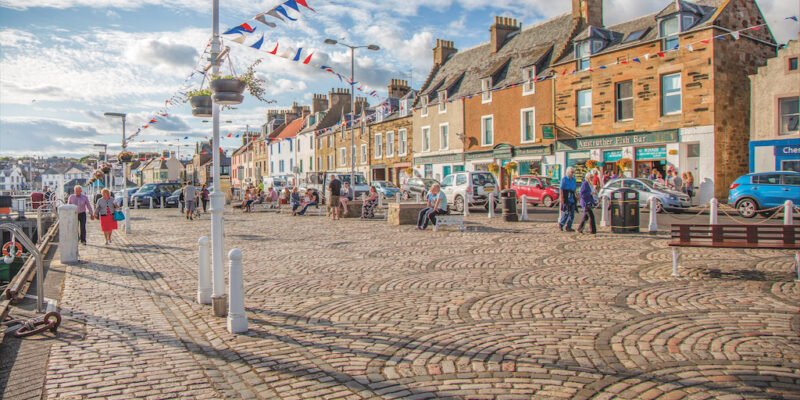This string of old fishing villages in Fife’s coastal nook is within easy travel distance of Edinburgh and Glasgow
MORE FROM SCOTLAND MAGAZINE
Credit: Stephen Mcginty
There are few places that illicit the spark of excitement necessary to turn an early rise from chore into pleasure than the prospect of a day spent on what King James VI once described as a “Fringe of gold on a beggar’s mantle.” Here we take a closer look at the East Neuk in Fife…
When King James VI described the East Neuk as such, he was dismissive of the poverty in the heartland of what many still describe as the ‘Kingdom of Fife’. Yet as tens of thousands of visitors each year will attest, the fishing villages of Crail, Anstruther and Pittenweem continue to sparkle.
I have a set routine, one chiseled in stone, when it comes to visiting the East Neuk of Fife. I like to rise early, breakfast in Glasgow and then set out on the road before 8am, so that before 10am I’m pulling into Balgove Larder farmshop, just outside St Andrews, to pick up a Scotch egg and a few other culinary comestibles – in summer Balgove also hosts a steak barn, which is not to be missed.
Once back in the car I push on to St Andrews for a coffee and browse through one of the finest book stores in Scotland, Topping & Company, from which I seldom depart without a purchase or two and then I sweep along the coast to the first of my ‘holy trinity’ of favourite places.
I love Crail. Even just saying the word brings a smile to my face and as I drive into this village of honey-coloured stone cottages I can almost feel my blood pressure drop and my shoulders relax as life suddenly becomes a little lighter. I wander along the central thoroughfare to see what properties are for sale and indulge in a little fantasy flitting, then follow the winding paths to the harbour.

If you’re visiting Crail and are a little peckish, then you won’t want to miss the little seafood shed that sits by Crail Harbour. Here, you can buy fresh lobster rolls, which can be eaten as you sit on one of the wooden benches nearby. Personally, I favour two lobster rolls over one, as I know from experience that one, while delicious, will always leave me hankering for another.
On my most recent visit, it was a little too early for lunch, so I contented myself with a stroll along the harbour, while peering from the quayside into the fishing boats below gently swaying with the swell.
Turning around and looking up at the cottages and buildings clustered around the quayside is like looking into a window to the past.
The roofs are constructed from tiles, a soft russet colour, which were brought back from ships trading with the Low Countries in the 16th and 17th centuries. In the past, I’ve whiled away a contented hour or so in the town’s little museum in which the history of the village and its fishing fleet unfolds in a series of sketches, black and white photographs and carefully curated artefacts, but today I leave it in the capable hands of its staff and a cluster of contented tourists.
As a child we would holiday in a rented house in the East Neuk, a few miles outside Crail, and each morning walk in to collect fresh milk, rolls and the morning paper. On this visit, I decided to try and retrace my steps and follow the coastal road back towards St Andrews in the hope that my memory would ignite, and I’d chance upon the little farmhouse we rented.

While I’d love to report that I was successful, I just couldn’t find it, which made me doubt my memories, however I did have a charming stroll and fell into conversation with an American couple, only too happy to extol the virtues of our summer weather in the East Neuk in comparison to the blazing heat of Texas.
By this time, I had worked up an appetite and felt it was time to drive a little further along the coast to Anstruther, where there has been a quiet revolution in dining in recent years.
In 2015, the Cellar Restaurant, tucked in a quiet alley just behind the Scottish Fisheries Museum, won a Michelin star, an incredible culinary accolade and a fitting one for Billy Boyer, a local chef who returned home in the belief that there was an appetite for fine-dining dishes of the highest standard.
Elegantly furnished, with an excellent selection of new Scottish gins, whiskies and international wines (our climate isn’t quite there yet) and a modern menu, the Cellar has become a fixed stop on a gourmet tour of Fife.
Though I was tempted by the menu, Anstruther is home to not one, but two of the finest fish ‘n’ chip shops in Britain, so I opted for haddock and chips, complete with a buttered roll and two pickled onions from the ‘Wee Chippy’, as opposed to the equally excellent but more famous Anstruther Fish Bar.
I ate my battered fish as I sat on the sea wall, gazing out towards the Isle of May, all the while battling cheeky seagulls. As I crumpled up the remnants of my greasy, vinegar-soaked newspaper wrapping, I made a mental note to award the ‘Wee Chippy’ one ‘McGinty’ star.

Each morning during the summer months, boats depart from Anstruther and head out to the Isle of May, the brown grey rock whose high cliffs are stacked with razorbills, guillemots and tens of thousands of puffins. The five-hour round trip usually allows visitors between two and three hours on the island, depending on the weather and the necessity for a swift retreat. Among the historic sites to visit is the remains of St Adrian’s Chapel, built in the 12th century, in memory of a monk murdered on the island by the Danes in 875 AD. It was a tempting trip but my next pilgrimage would lead me a little closer to home.
I decided to make a short detour to pay my respects to Alex Batchelor and his incredible house of shells. In the 1840s Mr Batchelor bought Buckie House in Anstruther, as it was formally known, and dedicated years to decorating almost every square inch with shells. A rather eccentric showman, Batchelor also commissioned his own coffin, similarly decorated it with seashells and then charged residents and visitors for tickets to gaze upon his final resting place. To run one’s hands over an artwork is a rare experience, as is stroking a house in broad daylight, but Buckie House prompts such actions.
By the time I reached Pittenweem, it was late afternoon and although the sun was finally breaking through the clouds, my destination was even darker. Pittenweem means ‘place of the cave’ and the stone chamber to which it refers is St Fillan’s Cave, a Christian curiosity and a place both eerie and evangelical, with just a touch of kitsch, for there can’t be that many places where pilgrims are asked to collect the keys from the local chocolate shop.
Just off the Main Street, an iron gate formed from Celtic crosses guards the entrance and then stone steps lead down into a darkened chamber, subtly illuminated, in which stands a simple stone altar.
St Fillan, an Irish saint, who according to legend tamed wolves to pull ploughs like oxes, and could read in the dark by the light of his illuminated hand, dwelt in the cave in the 7th century and would say a rudimentary Mass.
I found the stillness of the cave quite comforting, but this was in the knowledge of a safe, convenient departure. It must have been terrifying for the mentally ill who were bound and left overnight in the hope of healing. If their bonds were loosened by daybreak it was sign of a healing (and not frantic attempts of escape). Later the cave was used by smugglers, and I found pondering the stone crevices packed with illicit booty to be quite cheering in comparison.

Those wishing for an alternative subterranean adventure should travel just three miles north of Anstruther to one of Scotland’s most intriguing tourist attractions: the Secret Bunker. Lying 100 metres beneath a nondescript brick house is the labyrinth of corridors and offices where Scotland’s civil servants and senior military figures would have retreated in the event of a nuclear attack. It is one of the most chilling and grimly fascinating places in the country and I guarantee you will view the blue sea and sky with new adoration after an hour deep underground.
If Anstruther has profited from an influx of foodies, Pittenweem has benefited from an explosion in the arts, with a cluster of small galleries whose wares and exhibitions are spotlighted each August during a week-long arts fair. I popped in for a quick browse round the paintings, textiles and prints on display at the Backgate Gallery, before wandering round to the Coach House, both of which play key roles in the annual fair.
The interior of Fife may no longer be described as a ‘beggar’s mantle’ as James VI dismissed it, but his description of a ‘fringe of gold’ holds firm and with every visit I make it seems to become ever more burnished and brighter.
I admit that a part of the appeal is a return, however briefly, to those ‘blue remembered hills’ of childhood holidays. Every visit I make contains a brief slipstream into the past, when the cottages, nets and quayside of today are subtly replaced by an identical scene from 1982, when the soundtrack echoes to the delighted cries of my siblings and I can see the smiles on my parents’ faces.
Sitting in the West End Bar at Pittenweem, minutes before, sadly, taking my leave, I decided that these three little fishing villages in the East Neuk are, to me, pearls on a string and as priceless as a king’s ransom.
Read more:
MORE FROM SCOTLAND MAGAZINE

SCOTLAND MAGAZINE
Published six times a year, every issue of Scotland showcases its stunning landscapes and natural beauty, and delves deep into Scottish history. From mysterious clans and famous Scots (both past and present), to the hidden histories of the country’s greatest castles and houses, Scotland‘s pages brim with the soul and secrets of the country.
Scotland magazine captures the spirit of this wild and wonderful nation, explores its history and heritage and recommends great places to visit, so you feel at home here, wherever you are in the world.